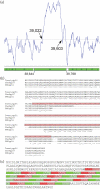Comparative genomic analysis of mycobacteriophage Tweety: evolutionary insights and construction of compatible site-specific integration vectors for mycobacteria
- PMID: 17660435
- PMCID: PMC2884959
- DOI: 10.1099/mic.0.2007/008904-0
Comparative genomic analysis of mycobacteriophage Tweety: evolutionary insights and construction of compatible site-specific integration vectors for mycobacteria
Abstract
Mycobacteriophage Tweety is a newly isolated phage of Mycobacterium smegmatis. It has a viral morphology with an isometric head and a long flexible tail, and forms turbid plaques from which stable lysogens can be isolated. The Tweety genome is 58 692 bp in length, contains 109 protein-coding genes, and shows significant but interrupted nucleotide sequence similarity with the previously described mycobacteriophages Llij, PMC and Che8. However, overall the genome possesses mosaic architecture, with gene products being related to other mycobacteriophages such as Che9d, Omega and Corndog. A gene encoding an integrase of the tyrosine-recombinase family is located close to the centre of the genome, and a putative attP site has been identified within a short intergenic region immediately upstream of int. This Tweety attP-int cassette was used to construct a new set of integration-proficient plasmid vectors that efficiently transform both fast- and slow-growing mycobacteria through plasmid integration at a chromosomal locus containing a tRNA(Lys) gene. These vectors are maintained well in the absence of selection and are completely compatible with integration vectors derived from mycobacteriophage L5, enabling the simple construction of complex recombinants with genes integrated simultaneously at different chromosomal positions.
Figures





References
-
- Banerjee, A., Dubnau, E., Quemard, A., Balasubramanian, V., Um, K. S., Wilson, T., Collins, D., de Lisle, G. & Jacobs, W. R., Jr (1994). inhA, a gene encoding a target for isoniazid and ethionamide in Mycobacterium tuberculosis. Science 263, 227–230. - PubMed
-
- Barsom, E. K. & Hatfull, G. F. (1996). Characterization of Mycobacterium smegmatis gene that confers resistance to phages L5 and D29 when overexpressed. Mol Microbiol 21, 159–170. - PubMed
-
- Bastin, D. A., Lord, A. & Verma, N. K. (1997). Cloning and analysis of the glucosyl transferase gene encoding type I antigen in Shigella flexneri. FEMS Microbiol Lett 156, 133–139. - PubMed
-
- Bibb, L. A. & Hatfull, G. F. (2002). Integration and excision of the Mycobacterium tuberculosis prophage-like element, φRv1. Mol Microbiol 45, 1515–1526. - PubMed
-
- Bibb, L. A., Hancox, M. I. & Hatfull, G. F. (2005). Integration and excision by the large serine recombinase φRv1 integrase. Mol Microbiol 55, 1896–1910. - PubMed
Publication types
MeSH terms
Substances
Associated data
- Actions
Grants and funding
LinkOut - more resources
Full Text Sources
Molecular Biology Databases
Research Materials

